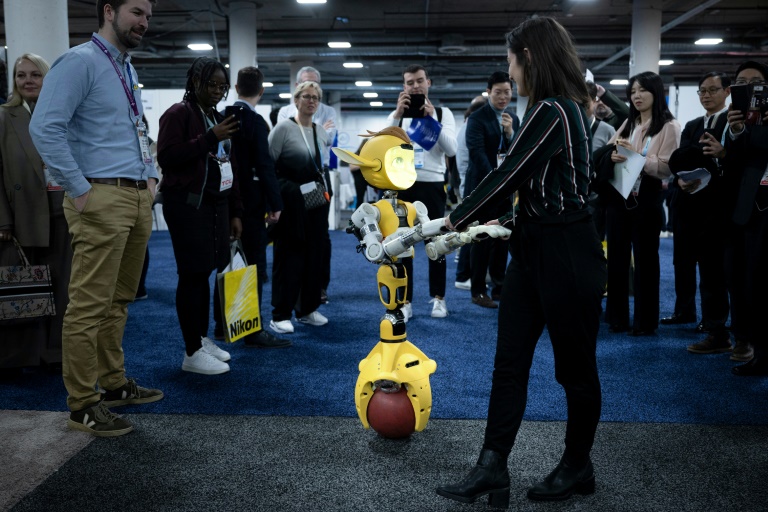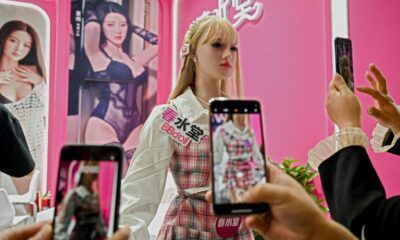With big, expressive eyes, elfin ears and adorable cooing, Miroka and Miroki could be an apparition from your favorite cartoon.
But behind their cute facade, these robots are all sensors and engineering, and designed to perform the drudgery of logistical support in hospitals or hotels.
“Why live with ugly machines,” says Jerome Monceaux, head of Paris-based start-up Enchanted Tools, who was on hand to present the pair at the CES tech show in Las Vegas.
“I could cut their heads off and erase their colors, but I’m not sure you’d want to share your daily life with them,” he continues.
A number of start-ups are working on robots that look familiar and help humans, without making them feel uncomfortable or unsafe.
Amazon is currently testing Agility’s “Digit”, a two-legged android that wouldn’t look out of place in Star Wars, to carry plastic bins in its warehouses.
Enchanted Tools has also bet on team-playing robots, designed to relieve staff of repetitive tasks.
But in addition to helping out, Miroki is meant to bring a touch of “wonder” to the workplace.
“It’s a way of celebrating something very beautiful in ourselves and avoid becoming machines ourselves,” said Monceaux.
His company hopes to produce 100,000 robots over the next 10 years.
– Filling jobs –
Every CES brings its share of companion robots and androids, but they haven’t gained much ground in homes and businesses.
At the same time, “labor shortage has been the number one problem since Covid across different industries. Today, we have roughly 18 million job vacancies,” said Joe Lui, the global lead on robotics at Accenture.
And while some tasks have been adapted for mechanical arms and autonomous forklifts, many others require language, mobility and understanding of the environment and therefore humans.
Or humanoids infused with artificial intelligence, said Lui, who thinks AI can bring robots into everyday life.
“Humanoids are going to be really like coworkers in the coming years and natural language interfaces like ChatGPT are going to be prevalent,” said Chris Nielsen, head of Levatas, a US company that has integrated generative AI software into Spot, a quadruped robot from Boston Dynamics.
Thanks to generative AI, robots depend less on pre-written scripts.
But “don’t worry, robots like us are designed to help humans make their lives better,” robot Moxie told AFP.
“We always follow the instructions and programs that humans give us. So you have the control.”
As tall as a teddy bear and doped with generative AI, Moxie is capable of interacting with children, telling them stories, giving math lessons and performing dance moves with two arms.
“Moxie isn’t here to replace anyone. Moxie is a mentor, tutor and a friend,” said Daniel Thorpe of Embodied, the company that created the robot.
– ‘Frightening’ –
Two-legged, mobile and autonomous humanoids still have a long way to go before they leave the laboratory.
But some of their precursors have at least made it out of CES, like Moxie or Aura, a highly anthropomorphic robot that entertains patrons at The Sphere, Las Vegas’ new concert venue.
“I receive a lot of questions like how old are you, what’s the meaning of life, who’s going to win the Super Bowl?” said Aura to curious viewers.
Aura punctuates her answers with jokes, exaggerated laughter and even rolls her shoulders into a shrug.
For Monceaux, highly anthropomorphic robots risk “provoking an epidermic reaction. They create confusion between our humanity and their robot nature, and are frightening.”
“Nobody wants to have one in their home or hospital on a daily basis,” he said.
Above all, he added, “it creates an expectation of behavior similar to our own”, and therefore a risk of disappointment, because the robot doesn’t see and understand the world as we do, and won’t for years to come.”
For Jonathan Hurst, co-founder of Agility, its Digit robot would look strange without a head and creep out humans.
“We had a lot of conversation about that internally at the company” and the head was kept even if it provided no significant technical purpose.
At CES, Adam, a robot barista from Richtech Robotics, serves coffee to delighted attendees and can now make jokes, thanks to generative AI.
But to refill the coffee machine with milk, he still needs humans.

 Business5 months ago
Business5 months ago
 Business4 months ago
Business4 months ago
 Events3 months ago
Events3 months ago
 People4 months ago
People4 months ago
 Events6 months ago
Events6 months ago
















